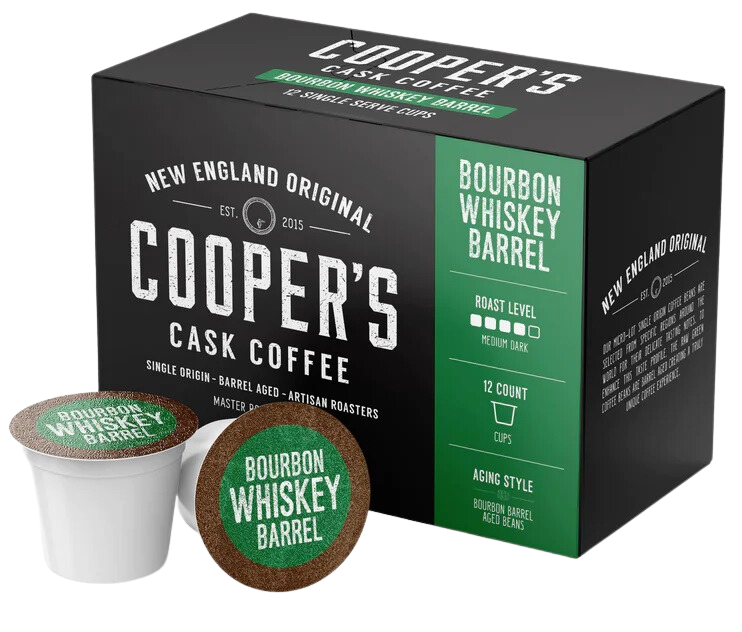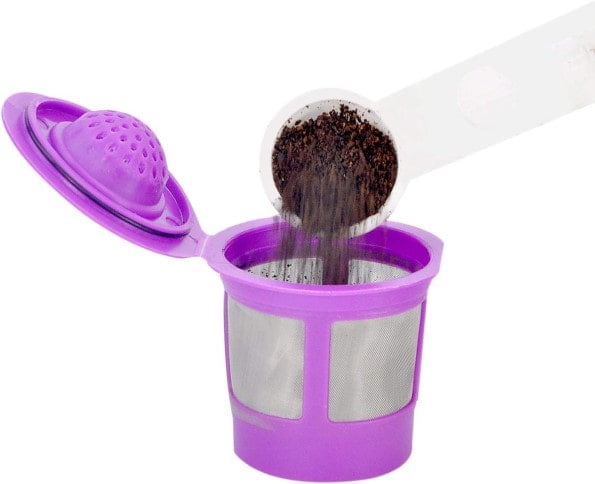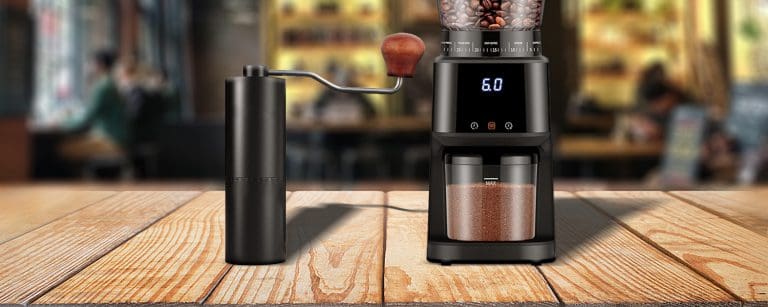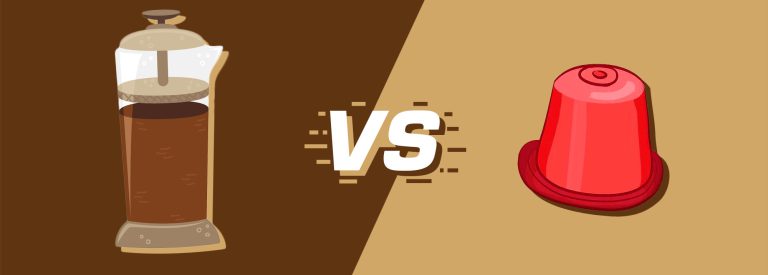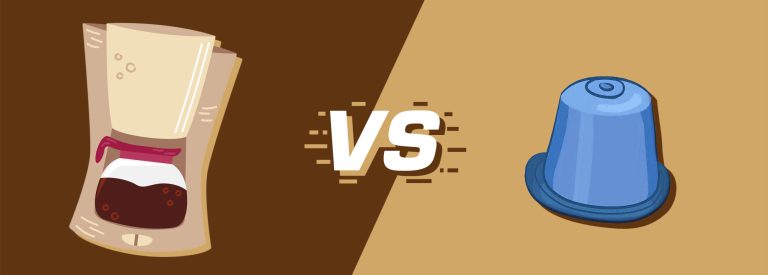Will Reusable Coffee Pods Save the World?
One of the environmental concerns that have caught the public’s attention is the piles upon piles of coffee pods ending up in landfills each year. It’s a major environmental issue as it contributes to the growing problem with plastic disposal. Yet, many coffee pod producers pledge to make things right by providing alternatives: both fully recyclable or fully compostable single-use coffee pods. Evidence suggests this won’t necessarily solve the problem. Could reusable coffee pods save the earth? Let’s explore this topic and help you find some solid, reusable coffee pods for your arsenal.
What are Reusable Coffee Pods?
Reusable coffee pods are usually made of plastic, stainless steel or aluminum. These are specifically designed for pod coffee machines such as Nespresso and Keurig. Unlike single-serve coffee pods where you have to throw it away after a single use, reusable coffee pods allow you to refill them with the coffee grounds of your preference – almost like a miniature moka pot.
We’ve featured some highly reviewed products (below) or you can DIY like the guy in this video! To reuse a recyclable coffee pod, you’ll need to use some hacks, some caution, and some common sense. There are some drawbacks to using reusable coffee pods. These are:
- Reusable plastic coffee pods might damage your pod machine if you’re not aware of the kind of plastic material used in manufacturing the pods. If the coffee pods are made of substandard plastic material or used improperly, chances of coffee pods bursting is high.
- Advanced software allows each coffee machine to know what’s going into its chamber so not every substitute will brew. In fact, the barcode on each nespresso vertuo pods tells the computer how to brew (duration, water, speed, etc.) Only the best reusable pods will work with these machines.
- Aluminum poses danger when used as a cookware where it will come in contact with water. Since brewing coffee involves hot water, Aluminum components end up being absorbed by the coffee grounds. Although small amounts of Al might be present in the coffee, strict precautions are highly advised.
- If you’re willing to fill a vessel with ground coffee each time you want to drink some, why not explore a more traditional coffee brewing method? Coffee pods are awfully convenient and that’s the real problem.
Coffee Pods 101
Have you ever wondered about the coffee pods’ origin? This compact container of coffee grounds that are loaded in coffee machines to make palatable coffee was invented in 1986 by a French-speaking Swiss and aerodynamics engineer named Eric Favre. If it wasn’t for his wife, Anna-Maria who challenged him about making a bland coffee tasty, Nespresso wouldn’t be invented.
To date, you can find various coffee capsules made from different materials. The materials used to make coffee pods has a direct impact on how coffee tastes and to our environment. Most of the materials used for coffee capsules are plant or cornstarch-based compostables, Polybutylene Terephthalate (PBT) plastics and Aluminum.
The coffee pod pioneer, Nespresso, manufactures their capsules out of Aluminum while other coffee roasters use the compostable and plastic capsules. Yet, many coffee roasters nowadays are adopting the use of Aluminum as an alternative to promote environmental sustainability.
Nespresso vs Keurig
Recognizing who’s better in making coffee between Nespresso and Keurig is difficult as both are excellent pod machines in brewing delectable coffee. Yet, its value always depends on the needs of the coffee drinker who will be using either of the two coffee machines to make their morning joe. Yet, with all honesty, which coffee maker is better?
For you to identify if Keurig and Nespresso can meet your coffee expectations, we highlight the features of these pod brewing machines below.
Nespresso
- Origin: Switzerland (Nestle Group)
- Marketability: Nespresso is a popular coffee maker in Europe.
- Variety: Nespresso comes in two product lines – the VertuoLine and the OriginalLine.
The VertuoLine is manufactured for Canadian and North American consumption for its ability to produce coffee in larger servings. It uses the centrifusion brewing system, where the pods are spun to make a more thorough coffee blend. To start brewing, the machine reads the barcode in the Vertuo pods to identify how the grounds in the pods should be brewed.
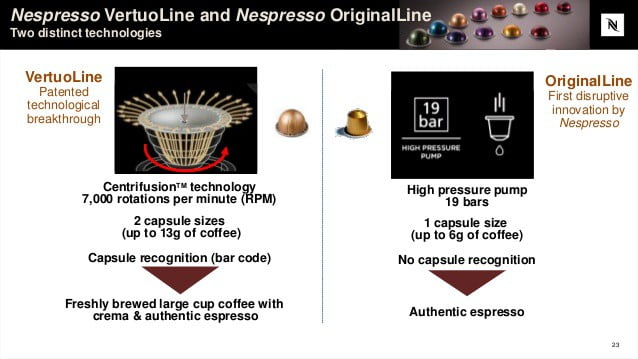
Quick Nespresso Vertuo Machine Recommendation:
The Vertuo Next coffee maker by Nespresso offers a range of coffee and espresso options in six sizes, featuring a compact and eco-friendly design using partially recycled materials. It is known for its precision brewing technology that ensures a full-bodied coffee experience with a velvety foam layer. The machine is exclusively compatible with Nespresso Vertuo capsules, which are fully recyclable and come with a complimentary starter pack of various coffee blends.
Keurig
- Origin: North America (Keurig Dr. Pepper)
- Marketability: Keurig is a popular coffee machine in the US, especially in office markets.
- Variety: Keurig has more than 60 K-cup brands as a result of partnering with a plethora of brands to produce the reusable K-cup.
Keurig sees to it that no matter what coffee machine is available in your kitchen, you can always find a reusable K-cup that you can use to brew coffee. This confidence comes from the fact that aside from over 50 different models of Keurig machines, various coffee brands also offer their blends in reusable K-cups.
This product features a water filter handle and a reusable filter for enhanced beverage taste, with temperature control ranging from 187° to 192°. It offers multiple brewing sizes (4, 6, 8, 10, 12 oz), a strong brew option, an iced setting, and hot water on demand, suitable for instant meals. Additional features include a large 75 oz water reservoir, a removable drip tray for larger mugs, and a maintenance reminder for descaling to maintain optimal flavor.
Why are Coffee Pods an Issue for the Earth?
Ever since Americans found convenience in using coffee pods to brew their coffee with the delight on the assortment of flavors available, its consumption increased. These single-use products might have brought convenience to the coffee drinkers, yet it has its dark side:
- Tens of billions of nonrecyclable and non reusable plastic coffee pods end up in landfills everyday.
- Plastic coffee pods will take thousands of years before it decomposes in the landfill, which adds to the growing problem with plastic pollution.
Both the convenience and creativity that coffee pods offer is countered with the growing concern over their environmental impact. According to Dr. Andrea Hicks of the Department of Civil and Environmental Engineering at UW-Madison on her research about coffee pods usage. The growing issue with coffee pods on Earth is not solely because of the technology use or the human behavior. “It’s somewhere in the middle of what people do with it.”
Meaning, the efficiency of the technology in producing sustainable products is useless in practice if its long term impact won’t be holistically assessed. If the impacts were properly assessed, consumers would be properly guided on how the coffee pods should be used.
Why are Coffee Pods convenient?
John Sylvan, one of the Keurig founders, had a goal to solve a common office coffee problem – a full pot of brewed coffee grows bitter and stale as it sits for hours waiting for the employees to slowly consume it throughout the day on their coffee breaks.
Meanwhile, Eric Favre invented Nespresso cups to prove to his wife that he can make delicious coffee. Favre invented the sealed pods where the air is trapped before hot water is forced inside to fill the cup with a frothy espresso. This barista technique helped Favre conclude that oxidation can bring out the best flavor and aroma of the coffee beans.
Judging from the reasons single use coffee pods were invented, it begs the questions: Are Coffee Pods superior to traditional coffee brewing? If so, why?
- Vacuum sealed pods guarantee the coffee beans are fresh.
- The length of time to brew coffee with the best reusable coffee pods is shorter than the traditional way of coffee making.
- One can maintain a wide variety of coffee pods in terms of flavor,and origins, and roasts
- Cleaning and maintenance is much easier.
User Guide for Reusable Espresso Pods
To properly operate your coffee pod machine with reusable espresso pods, here’s a simple user guide that you can follow.
How to use the reusable pods (steps)
- Fill the empty, clean pods with ground coffee. You can use a coffee burr grinder to grind the coffee beans to an espresso grind size. Make sure that the grounds are not too thin (because it might clog the capsule) or too big (because the water will easily pass through it).
- After filling the pods with ground coffee, pack it with a cork or a tamper. Once you’ve packed the grounds, seal the capsule. Make sure the seal is in place and there’s no grounds falling.
- Load your reusable espresso pods in your machine. It’s ready for brewing coffee.
Sizes
The size of the pods matters for you and your machine’s safety. You can’t just load your pod machine with any pods without identifying if its size is compatible with your machine. So if you’re looking for an espresso pod, here are the different brand pod designs and its sizes on which most reusable coffee pods are based.
- Keurig 1.0 (k-cups) – these are the most common
- Keuring Vue- specially sized pods
- Keurig 2.0 (licensed cups only)
- Nespresso Original – 37mm x 30mm
- Nespresso Vertuo – various sizes
- Espressi/K-Fee Aldi – 45mm x 25mm
- Nescafe Dolce Gusto – 37mm x 54mm
- Lavazza Blue Capsules (US)
- Caffitaly – 45mm x 25mm
- Lavazza A Modo Mio – 47mm x 17mm (N/A in US)
- Espressotoria (Vittoria) – 37mm x 30mm
- Easy Serving Espresso – 44mm
Materials
Coffee roasters have come up with innovative ways to make their coffee pods environmentally friendly and sustainable. Most of the coffee pods produced are often made of the following materials:
- Stainless steel
- Paper or silk
- BPA-free plastic
- Bamboo resin and corn
Brand Compatibility
When it comes to brand compatibility, Keurig is a bit ahead of Nespresso. Instead of producing their own line of K-cups, Keurig partners with coffee roasters to produce K-cups to supply the need for coffee pods that will fit to any coffee machine. So when you buy coffee, some roasters offer their grounds in eco-friendly pods.
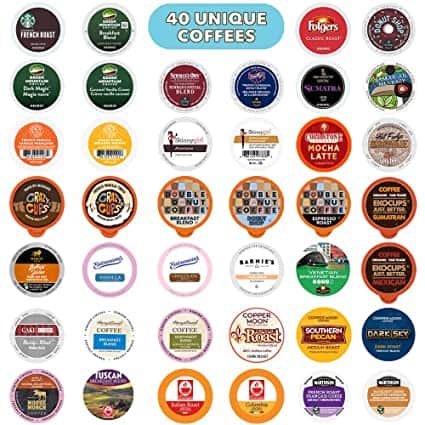
K-Cups We Recommend
Here are our favorite K-cups from roasters we trust:
This popular coffee blend, now available in k-cups, is known for its balanced flavor profile featuring a harmonious mix of caramel and chocolate flavors with subtle notes of pepper and tobacco, offering a smooth, gentle acidity and a rich, full body. The roast level is neither too light nor too dark, resulting in a warm, inviting taste with a long-lasting finish.
The Kenya AA Espresso Capsules contain 100% Arabica coffee, offering a bright, complex, and sweet flavor with less acidity than other African coffees. These Nespresso OriginalLine-compatible capsules are ideal for single shots or espresso-based drinks, boasting a wine-like brilliance and rich crema. The product emphasizes sustainability, featuring recyclable aluminum capsules and packaging, with the coffee grounds being home-compostable.
Model Compatibility
When you buy a pod coffee machine, you have to be weary about the number of compatible pods for your machine. You are paying less for the machine and more for the continual acquisition of the product specific pods. Worry not! While there are many different brands, the two primary ones we’re focusing on are Nespresso and Keurig.
The Future of Coffee Pods
Will every roaster have to sell pods to stay in business? With coffee being the most widely consumed beverage around the world, there’s hope for coffee pods to prosper. However, it does not guarantee a brighter future for some coffee roasters due to two reasons: the packaging and the disposability/recyclability concerns.
These reasons constrain the growth of the coffee pod market. Yet, Nespresso, the leading coffee pod marketer continues to innovate their coffee pods by recycling 80% of its used coffee capsules through their 14,000 capsule collection and recycling centers in 31 different countries. This is notable because Nespresso controls the recycling process on its own terms rather than yield to local State/Municipal policies that have – sadly- allowed a great deal to end up in landfills. Curious how to clean your Nespresso machine and keep it running efficiently? Check out this article from the Daring Kitchen.
Although a lot of coffee roasters are switching their traditional way of packaging their coffee beans to reusable coffee pods, some of it still ends in landfills. For now, it’s too early to predict the fate of coffee pods and coffee roasters because the demand for coffee pods still rises and the demand for new products continues to grow. Are compostable pods the answer? This is a complex question but certainly worth exploring. Here is more info about composting plastics.
According to the International Coffee Organization (ICO), the trend for coffee pods still rises because of the technological advances and the rising demand for easy-to-use capsules. At present, Scandinavian countries still hold the records with the highest coffee consumption rates with Norway leading the list with 9.9 kg per capita, followed by Denmark (8.7kg per capita), and Sweden (8.2kg per capita).
Our Favorite Reusable Coffee Pods
You’ve got your dream coffee machine that uses coffee pods, now what? If you’re looking for the best reusable coffee pods, we’ve listed some of the reusable coffee pod favorites. Enjoy!
NESPRESSO Favorites
Original Nespresso Line Reusable Refillable Capsules
The Original Nespresso Line capsules are versatile reusable coffee pods that allow you to create delectable latte, cappuccino, espresso, or Americano. The capsules are directly compatible with all the Nespresso Original Line Models.
- Original Line Nespresso
- Pack of 6 – Multiple Units so you can pre-fill your coffee pods all at once
- BPA free plastic
- Has a built-in stainless steel micro mesh filter
A cost-effective and eco-friendly alternative for Nespresso machines, allowing users to use their favorite coffee blends instead of pre-packaged pods. It is compatible with all original line Nespresso models and is made of durable, non-toxic materials, ensuring extended use and environmental sustainability. The design features a stainless steel micro mesh filter for easy cleaning and repeated use, promoting both convenience and a reduced carbon footprint.
iCafillas Stainless Steel Reusable Capsules
The iCaffilas reusable capsules are made of the finest stainless steel and come with replacement seals.
- Vertuoline Nespresso Compatible
- Delonghi ENV 135 and 150 compatible
- Stainless Steel
- 2.4 oz (espresso size only)
- NOT for Keurig
This consists of 120 food-safe espresso lids designed to fit VertuoLine pods, but not compatible with Nespresso Original Line or Dolce Gusto Capsules. These 64mm diameter lids are thick, leak-proof, and intended for recycling and reusing Nespresso pods. The package also includes a coffee spoon, and the lids are easy to use, even with previously used Vertuo pods.
The Coffee Seal Reusable Stainless Steel Capsule
The Coffee Seal Capsule is a full cup reusable capsule.
- Works Vertuo Nespresso Coffee Machines
- 5oz (makes large coffees)
- Can hold up to 12 grams of coffee
- Can make an 8 ounce of brewed coffee
- Crafted using a food-grade 304 stainless steel
- Comes with a barcode
- Not dishwasher-safe
The Coffee Seal offers an eco-friendly and cost-effective solution for coffee lovers, being a 100% reusable capsule compatible with various machines. It can hold 12 grams of ground coffee for a full-flavored 8 oz cup and is crafted from food-grade 304 stainless steel for safety and longevity. User-friendly and complete with a coffee brush, scoop, and machine-compatible barcode, this capsule simplifies the brewing process and maintenance, reducing environmental impact and the need for single-use capsules.
KEURIG Favorites
DeliBru Universal Reusable K-Cup
The DeliBru Reusable Pods are compatible with any Keurig 2.0 and 1.0. It doesn’t require Keurig filter holder switching because the cups fit with its recessed bottom anyway you insert it.
- 100% BPA-free
- Dishwasher safe and Easy to Clean
- Features a tight seal to avoid leaks
- Compatible with BOTH 2.0 and 1.0
- 4-pack
DeliBru's reusable K-cups offer an eco-friendly solution to the waste created by traditional single-use pods. If you use a Keurig, this product offers a way to brew delicious coffee while reducing your environmental impact.
Occasional leaks can occur though, but you'll still find DeliBru's BPA-free and dishwasher-safe design well worth it for the cost savings on individual pods, and sustainability benefits.
My K-Cup by Keurig
Keurig’s My K-Cup is compatible with any Keurig 2.0 and 1.0 Brewers, but it doesn’t work with ALL Keurig models – such as Keurig K400, Mini, and compact. This reusable K-cup is easy to use because it doesn’t require swapping the Keurig filter or any kind of tamper to fit the capsules into the machine seamlessly. It is made from 100% BPA-free stainless steel mesh.
The Keurig My K-Cup Universal Reusable Filter allows for brewing ground coffee in Keurig coffee makers and is compatible with all Keurig home models, featuring MultiStream Technology for enhanced flavor extraction. It offers a simple brewing process and easy cleaning with its removable lid, designed for convenience and ease of use. The filter is durable, dishwasher safe (top rack only), BPA-free, and constructed with high-quality materials for safety and reliability.
Other Pods
IPartsPlusMore Reusable K-Cup Pods
The iPartsPlusMore Reusable pods allow you to cut your carbon footprint while cutting your coffee-making expenses. It is made from durable BPA-free plastics with built-in stainless steel, micro-mesh filter. It works well with Keurig B31, B40, B44, B50, B60, B66, B70, B77, B140, B200, CuisinArt K-Cup, Mr. Coffee Art K-Cup, and Breville K-Cup.
The product is a set of reusable coffee filters for Keurig machines, designed to reduce waste and cost compared to single-use pods. Made from BPA-free, high-grade stainless steel, these filters offer a quality brewing experience, allowing the natural oils in coffee beans to pass through. They are easy to use, compatible with many Keurig models, and are an environmentally friendly and cost-effective alternative to disposable K-cups.
Alternatives
EZ Cup 2.0
The EZ Cup 2.0 resembles Keurig K-cups but is much easier to use because it doesn’t require the peeling of the aluminum lid to recycle the k cups properly.
- Made of thick BPA-free plastic capsule
- Comes with compostable paper filters
- Compatible with Keurig and other brewing machines.
The Perfect Pod EZ-Cup 2.0 includes a reusable cup and 25 biodegradable filters, offering an environmentally friendly and cost-effective alternative to pre-filled K-Cups. Its patented design ensures easy cleanup and optimal brewing consistency, enhancing the overall coffee experience. The use of these filters reduces environmental waste and can save users up to 80% compared to prefilled coffee pods.
Uncommon Coffee Roasters Eco-friendly Pods
It’s the ‘greenest’ reusable pods that is compatible with the majority of Keurig coffee machines and other commercial brewing systems.
- Made of corn-based materials and bamboo resin
- Decomposes within 90 days
The product is a pack of 10 newly improved, 100% compostable single-serve coffee cups that are sustainable and environmentally friendly. It offers two varieties: House Blend and Water Processed Decaf, the latter being decaffeinated using a natural process involving CO2 and water, avoiding chemical residues. The packaging is 100% recyclable, with minimal ink usage, and the cups are compatible with Keurig 2.0 brewing systems.
Why is my Keurig machine not accepting other pods?
This is a rare case today, but if your Keurig machine doesn’t accept reusable coffee pods from other brands, chances are, it still has the strict DRM restriction in Keurig 2.0 coffee makers produced in 2014.
After complaints from users, Keurig has allowed for more compatibility with other reusable K-Cups in the market. But if you still need to bypass this, you can try buying a coffee pod that works with your machine, and just stick the label on top of your reusable pod.
Our Favorites – Who Has The Best Social Mission?
This is a hard question to answer. Clearly, Nespresso was built with a recycling model at its core. However, Keurig has created a new vehicle for coffee producers to share their products with the World. Vacuum sealing enhances shelf life and the volume of coffee needed for a good cup of coffee. Plus, initiatives in the last decade have shown Keurig to have a clear solution to address landfill and compost concerns.
Personally, I’ve been intrigued by the success of these coffee pod models, but I am old-fashioned and have stuck with traditional brewing methods. I don’t like having to rely on a packaged product or a sophisticated machine to enjoy my daily dose of coffee. Therefore, I’m leaving it up to you to decide which of the market leaders has our environment in mind. In the meantime, please let us know your thoughts on this subject and we’ll continue to review the products we think are doing their best to keep quality standards high and the people and places that produce coffee as healthy as possible.
Becoming environmentally conscious is not a hype but a must. It’s our moral obligation to protect the Earth from destructive activities. A small act can add up to create a huge impact. As ordinary citizens, you can do so something for our planet. This starts with our buying decisions.





